This winter I have taken on the responsibility of keeping the two feeding stations at Forest Park supplied two days a week, on Thursdays and Fridays. I’ve made sure to get there both days during periods of inclement or extremely cold weather but if the weather is warm and nothing is falling from the sky I usually only fill them on one day. What I have learned is that the birds that come for the seed that I scatter, like White-throated Sparrows, Dark-eyed Juncos, and Mourning Doves, tend not to be terribly impatient and don’t seem to be in a big rush to get to my largess. The woodpeckers and nuthatches that come for the suet that gets smeared on the side of a particularly large tree, on the other hand, are extremely impatient and will call and scold from rather close range until their suet is set out for them.
Squirrels, though usually around the park in rather large numbers, don’t tend to get the suet, mostly because the birds vacuum it down before they get the chance to eat it, which makes the cayenne pepper suet that I occasionally use superfluous. But beyond being greeted by hungry birds I enjoy watching the different strategies the birds use to get the suet and their methods of eating it.
For example, White-breasted Nuthatches like the ones above and below tend to grab great chunks of suet and fly off to a convenient branch where they gobble it down in smaller chunks. This occasionally leads to a comical situation where a nuthatch literally bites off more than it can chew and has to drop its chunk of suet and pick up a smaller section. This, of course, is a boon to the titmice and sparrows which seem to appreciate the suet being on the ground rather than on the side of a tree.
The woodpeckers, on the other hand, seem willing to prop themselves up next to the suet and eat it as they get it loose from the tree. Red-bellied Woodpeckers try to get their lower mandible under the suet and pry it up, using their upper mandible to prevent the suet from flying off into the air. They also sometimes seem content just grabbing the looser parts of the suet in their beak without really doing much work at all.
Downy Woodpeckers tend to use their entire bill as a woodpecker is expected to, hammering away at the spot the suet meets the tree to loosen the suet before pulling it off the bark. Sometimes they just use their entire bill as a lever and pry the suet off that way.
Hairy Woodpeckers seem to mostly use methods similar to the Downy Woodpeckers, but they seem to use their longer bills as a lever more often than the downies do, and hammer at the suet less often. Oddly, at least from my preconceptions, it seems that the Hairy Woodpeckers in Forest Park are more willing to go to the ground for seeds that the Downy Woodpeckers do when there is no suet, a reversal of what I would have expected.
What is clear to me from closely watching these common birds is that the reason several similar species can all coexist in the same environment is because each is adapted differently to exploit food resources in slightly separate niches, leading to a decrease in competition, unless, of course, they are brought together by the generosity of humans…


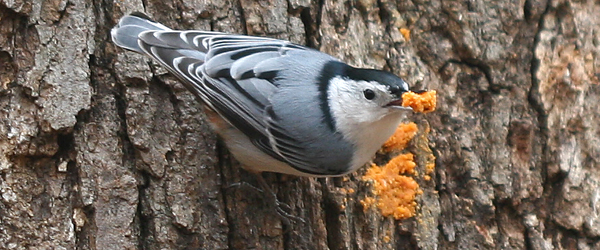
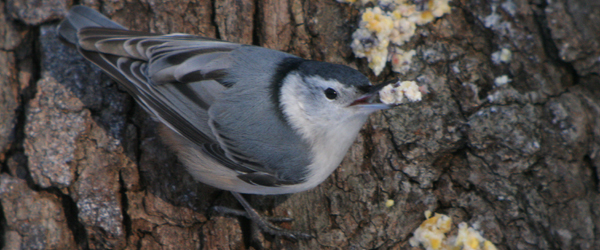
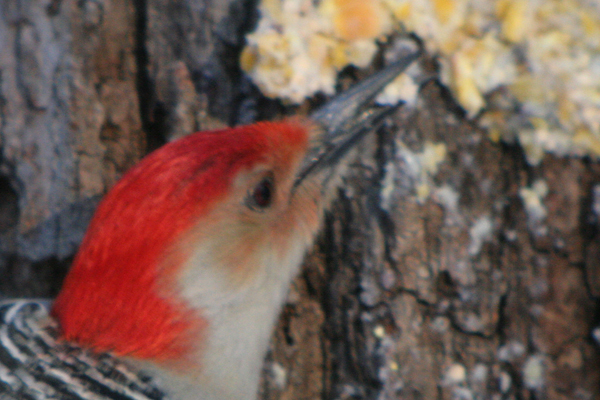
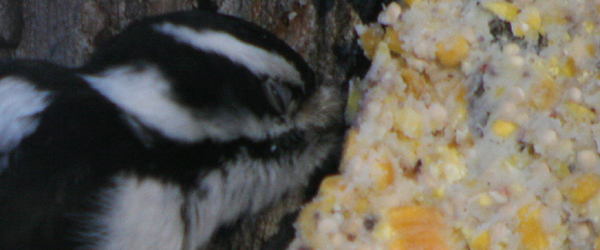
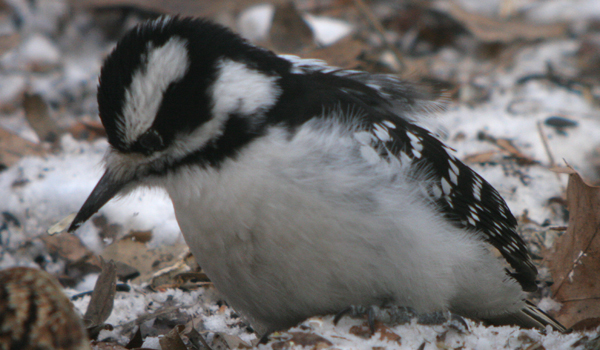











Beautiful images. The first image of the Nuthatch is my pick in this series.
I love the pictures, but have a special fondness of the red bellied. They are such beautiful birds
My suet feeding stations were in perfect harmony until two days agao when a pair of mockingbirds discovered my yard. Boy, do they devour suet. A whole block gone in one day!!! They are fun to watch, and are the only bird to stand up to the starlings so I guess I will just have to double up on making suet!
Great pictures. Do you make your own suet? I’d love to have the recipe.
Nice photos, the Nuthatch is my favorite.
Nice run down on the feeding habits of these species.
Thanks!
Cory, I’ve noticed an interesting phenomenon: I have a suet feeder with peanut dough which hangs flush against a dead-tree trunk and also a hardware-cloth cage with peanut pieces and black-oil sunflower seeds about 3 feet away suspended from a branch on the same tree. The male Hairy woodpecker ONLY eats the peanut pieces and performs contortions to cling to the feeder; the female Hairy woodpecker ONLY eats the peanut dough. Never the other way around.
Corey, thank you so much for following through and being consistent with feeding on your days. You have made this winter so much easier for me knowing I could depend on you and it was taken care of. I remember last year when you first came down to Queens you were surprised by the “very confiding birds” in the 2 areas. Now that you are one of the food sources, I am glad you are enjoying the activity as much as I do!
ps when do you go to Honduras, or are you already there?
they are really good uncle really really!! i love them sooo much especially the red bellied wood pecker
@Thomas: Thanks!
@Kallen305: Sometimes some extra suet is worth the extra effort!
@Tamatha: I’m too lazy but a recipe is here:
http://10000birds.com/peanut-butter-suet.htm
@MaineBirder: Thanks!
@Bosque Bill: That is weird…has anyone else out there ever noticed something like that?
@Jean: It’s a joy! And I don’t head out until next Sunday.
Wonderful post and love seeing the birdies eating this great suet mix!
Heath has a very good suet cake for woodpeckers, it is full of peanuts and almonds. http://www.gardenharvestsupply.com/product/heath-woodpecker-blend-suet
Hi Corey love your photos. We get many small woodpeckers at our feeders. The Red Bellied one hasn’t been around much this winter. We used to see Flickers too. I have a bird living in our vent duct from our downstairs bathroom. Not sure what kind of bird it is haven’t been able to see it. only hear it in there at night. It’s probably the same bird that was there during the summer. I don’t know what kind of bird it is. Have been looking in books but can’t quite figure out what species it is yet. I make my own suet too. I use beef drippings dry bread, sunflower seeds, berries,corn other left overs also egg shells. we freeze them and use them in between using store bought suet. The birds seem to like mine better. I also put onion bags filled with dryer lint out in the spring. The birds use it for their nests. This is better than when they use pieces of string and things that can get tangled around their feet and legs. In the past I’ve had to cut baby birds free from such nesting materials in my neighbors yard. Keep up the excellent bird watching and photography. I Love It!!!! Wbs if ya can. Sue